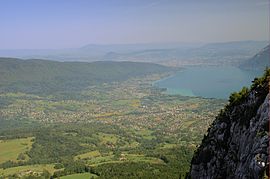Saint-Jorioz
Appearance
(Redirected from Saint Jorioz)
Saint-Jorioz | |
|---|---|
 The town seen from the Col de la Cochette | |
| Coordinates: 45°49′59″N 6°10′01″E / 45.8331°N 6.1669°E | |
| Country | France |
| Region | Auvergne-Rhône-Alpes |
| Department | Haute-Savoie |
| Arrondissement | Annecy |
| Canton | Annecy-4 |
| Intercommunality | CA Grand Annecy |
| Government | |
| • Mayor (2020–2026) | Michel Beal[1] |
| Area 1 | 21.12 km2 (8.15 sq mi) |
| Population (2021)[2] | 6,287 |
| • Density | 300/km2 (770/sq mi) |
| Demonym | Saint-Joriens / Saint-Joriennes |
| Time zone | UTC+01:00 (CET) |
| • Summer (DST) | UTC+02:00 (CEST) |
| INSEE/Postal code | 74242 /74410 |
| Elevation | 443–1,657 m (1,453–5,436 ft) |
| Website | Saint-jorioz.fr |
| 1 French Land Register data, which excludes lakes, ponds, glaciers > 1 km2 (0.386 sq mi or 247 acres) and river estuaries. | |
Saint-Jorioz (French pronunciation: [sɛ̃ ʒɔʁjo]; Arpitan: San-Zhouryo), located on the western banks of lake Annecy, is a commune in the Haute-Savoie department in the Auvergne-Rhône-Alpes region in south-eastern France.
Population
[edit]| Year | Pop. | ±% p.a. |
|---|---|---|
| 1968 | 1,831 | — |
| 1975 | 2,446 | +4.22% |
| 1982 | 3,344 | +4.57% |
| 1990 | 4,178 | +2.82% |
| 1999 | 5,002 | +2.02% |
| 2007 | 5,694 | +1.63% |
| 2012 | 5,752 | +0.20% |
| 2017 | 5,738 | −0.05% |
| Source: INSEE[3] | ||
World Heritage Site
[edit]It is home to one or more prehistoric pile-dwelling (or stilt house) settlements that are part of the Prehistoric Pile dwellings around the Alps UNESCO World Heritage Site.[4]
See also
[edit]References
[edit]- ^ "Répertoire national des élus: les maires". data.gouv.fr, Plateforme ouverte des données publiques françaises (in French). 2 December 2020.
- ^ "Populations légales 2021" (in French). The National Institute of Statistics and Economic Studies. 28 December 2023.
- ^ Population en historique depuis 1968, INSEE
- ^ UNESCO World Heritage Site - Prehistoric Pile dwellings around the Alps
Wikimedia Commons has media related to Saint-Jorioz.




